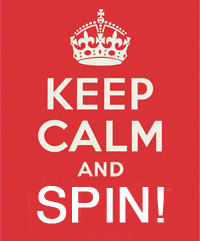
When I teach fiber spinning, I try to encourage students to look beyond the struggles they initially have with coordinating their hands with their brains. Sometimes I take on the role of a counselor, reassuring them that their frustration is only temporary. Their brains WILL coordinate with their bodies and soon all WILL come together and they WILL BE SPINNERS! The coordination isn’t instant for anyone and the amount of time to develop it varies with each person. There’s nothing wrong with being a slow learner when trying to coordinate the left and right brain. Calm down. Take a break. Re-approach and try again. This process of pausing, re-evaluating, and proceeding (remains me of the UK slogan: Keep Calm and Carry On), is actually an aspect of developing the neuroplasticity of the brain.
Neuroplasticity (the ability of the brain to act and react in new ways) is becoming a hot field within aging research. Researchers are finding that the brain DOES have the capacity to develop new “brain cells” aka “connections” as we age. In fact, if given the chance, the brain will thrive on new experiences. And this “garden” of growth can continue long into our aging—in fact, never ceasing until our death. Here’s a brief discussion of the longevity of neuroplasticity from memoryzine.com:
NEUROPLASTICITY CAN’T LAST FOREVER . . . CAN IT?
From Fresh Experiences Throughout Your Lifetime.Contrary to widespread belief, the “garden” of the brain never ceases being pruned and newly planted. Though long believed by scientists to be the case, research over the past decade or so has proven that our neural connections do not ever reach, by some age, a fixed pattern that thereafter cannot change. Rather, the ongoing process of synaptic reformation and death is what gives the brain its plasticity – its ability to learn and remember, to adapt to its environment and all the challenges brought with it, to acquire new knowledge and learn from fresh experiences – throughout an individual’s lifetime. Groundbreaking new research suggests that, beyond modifying pathways and forming new ones between existing neurons, the human brain is even able to generate entirely new brain cells. While this neural regeneration was long believed to be impossible after age three or four, research now shows that new neurons can develop late into the life span, even into the golden years of age 70 and beyond. Thus, the old adage “use it or lose it” is brought soundly home. If one’s brain is constantly challenged by and engaged with a variety of stimulations and new experiences, while also exposed regularly to that which it already knows, it is better able to retain its adaptive flexibility, regenerative capacity, and remarkable efficiency throughout life.
Learn more about Neuroplasticity here: http://memoryzine.com/2010/07/02/introduction-to-neuroplasticity/
So I present to you that learning to spin fiber is not only a lovely activity to create something unique and useful but also a way to further develop the neuroplasticity of your brain. It will provide a lifetime of benefits!
So… Keep Calm and Spin –

so your brain may Carry On!
Have you experienced a brain boost from spinning or another brain/body coordination activity such as knitting? Please share here!
For non-spinners, I encourage you to experience the brain benefits found in the spinning process. One tool to get you on your way is my new book “Yarn Works: How to Spin, Dye, and Knit Your Own Yarn”. In this book, you will learn about fibers; how to spin, dye and knit them; and discover the history of all aspects of yarn making by hand. See http://www.sagahill.com/Publications-Kits.html for more info.

This was a very interesting article Wendy. Thanks.
There’s another aspect to neuroplasticity than is being discovered in brain research. Some researchers are reporting that not only can new brain cells be generated as we age, but our brains can actually store or bank neurons from activities we do with our brain that can be used at a later time. This means the more we stimulate the brain from spinning, new brain cells can be invested so to speak in your “brain neuron bank” so that you can use them later – when you might need them more. JVG
LikeLike
That’s very encouraging! A better investment than money in the bank. Thanks Jim!
LikeLike